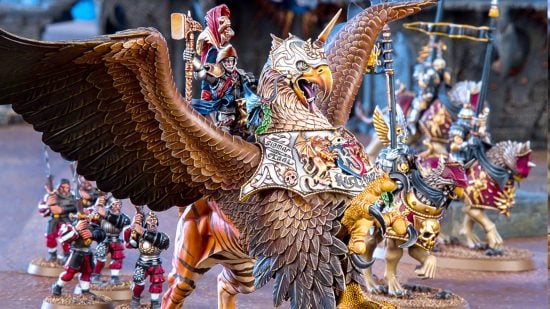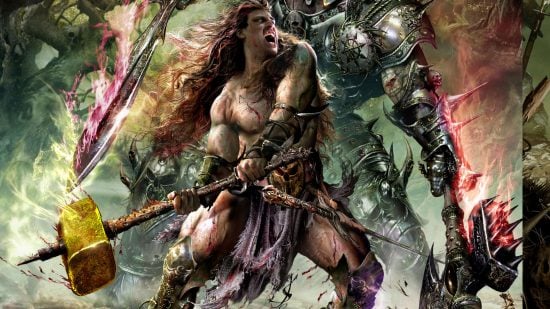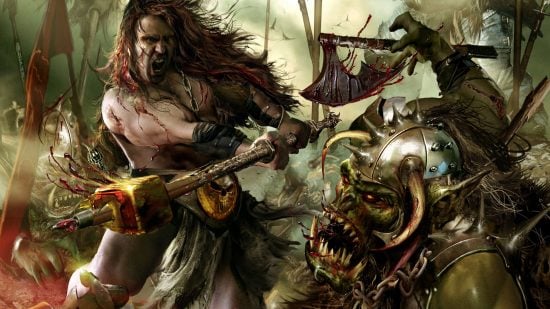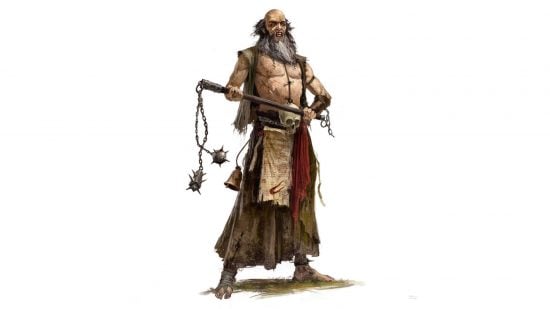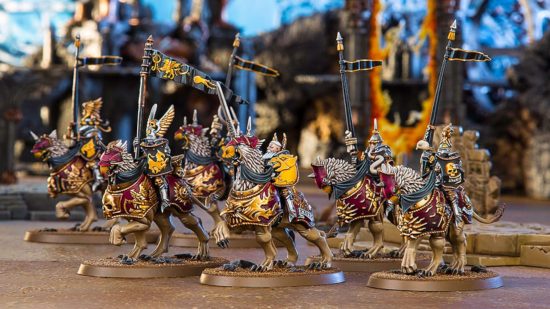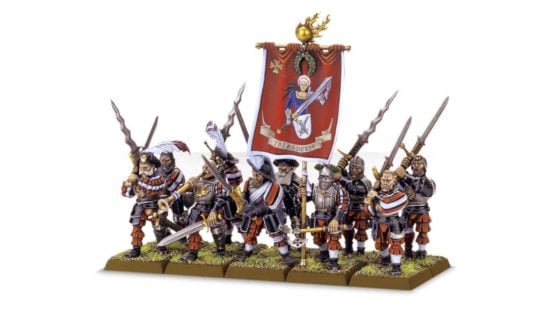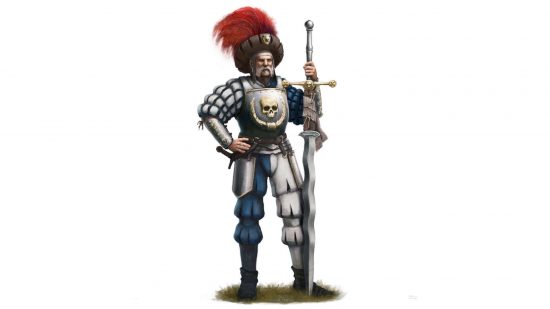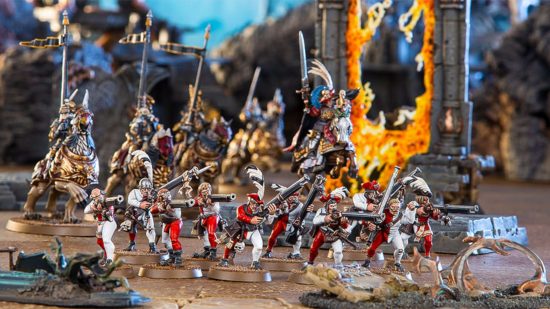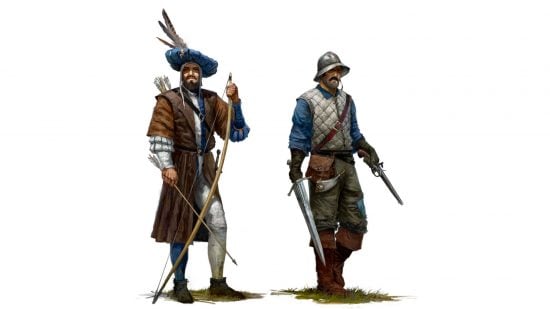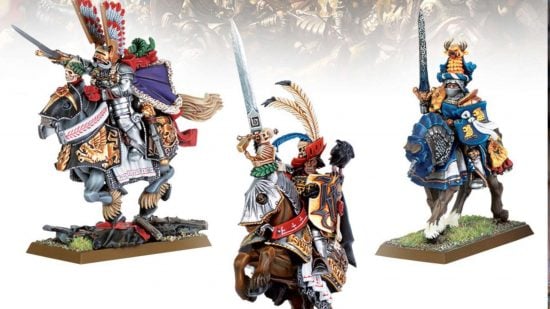The Warhammer Empire of Man is the largest and most powerful human nation in the Old World. Spanning the heartlands of the continent, it is a huge and varied land. Wildernesses of forest and mountains are studded with villages, market towns, and mighty, self-governing cities.
The Empires state armies field regiments of infantry, backed by the massed gunnery of the Nuln artillery school, while knights and nobles march to war on proud steeds and monstrous war griffons.
The Empire is the most flexible Warhammer the Old World faction to build an army for. Though it’s typically a mixed arms force, it’s possible to create a dedicated gunline or to strongly favor the Combat phase. You may want to supplement our guide to playing as the Empire with our Old World rules guide, as its flexibility means there’s no phase of the game you can ignore.
Here’s what you need to know to get started with the Warhammer Empire of Man:
Warhammer Empire of Man history
Most Empire of Man history is recorded in the annals of the Dwarfs, an ancient race whose civilization was already in its twilight years when mankind began its rise to ascendancy. Though it is now the single largest and most advanced human union in the Old World, the Empire’s origins were crude and barbaric.
Sigmar, founder of the Empire
The Empire arose from the bronze-age human tribes in the central lands of the Old World. Though numerous, the race of man was set upon by the many forces of disorder, from the Beastmen of the deep woods to the belligerent Orcs and Goblins that rampaged out of the hills in unstoppable hordes.
Sigmar was the son of the chief of the Unberogen tribe, his birth heralded by a twin-tailed comet blazing across the sky. He grew to become a mighty leader of his people, forging bonds of friendship and loyalty not only with the other tribes of men, but with the Warhammer Dwarfs. In recognition of Sigmar’s valor, the High King of the Dwarfs awarded him the ancient runic hammer Ghal Maraz, literally “Skull Splitter”.
The Dwarfs were weakened by a disastrous war against the elves, known as the War of the Beard, and their mountain holds were terrrorized by unending armies of greenskins. At the battle of Blackfire Pass, man and Dwarf stood shoulder to shoulder, turning aside the largest Orc Waaagh! yet to assail the Old World. This great victory secured a lasting piece for the tribes of men, and Sigmar became the first Emperor of the united tribes.
Sigmar lived into old age, but sired no heirs. He abdicated the throne at the age of 80, leaving the Empire for a journey into the East. He would pass into legend, becoming a god to the people of the Empire, the founder and patron deity of the nation.
Elector Counts
The Empire is divided into twelve electoral provinces, each ruled by an Elector Count who can trace his or her lineage back to the tribal kings that stood beside Sigmar during his wars against the greenskins and forces of Chaos. When the seat of the Emperor is vacant, the Elector Counts convene to cast their vote for who, among their number, will be next to rule.
Each Elector Count wields a powerful runic blade, called a Runefang, created by the Dwarfen master runesmith Alaric the Mad. These are among the greatest magical weapons known to humans, and potent symbols of the wielder’s authority within the political system of the Empire.
The Age of Three Emperors
In the millennia since Sigmar’s abdication, the Empire has been ruled by many Emperors from many Electoral regions. Bloodlines and territories have risen in power, while others have withered and fallen.
The Emperor Mandred von Zelt of Middenheim was a popular and charismatic figure, uniting the people of the Empire against the dreaded Skaven ratmen that had terrorized the land for years. When he died, the Electors could not decide upon a successor. The interregnum eventually devolved into outright violence, as first one, then two, and finally a third contender declared themselves Emperor. By 1547 the Empire was wracked by civil war.
The turmoil from this conflict endured for centuries. With the Empire divided into a mass of bickering states, its enemies were easily able to exploit its weaknesses. Orcish invasions sacked whole provinces, while the machinations of the Undead saw the province of Sylvania ruled for centuries by Vampires of the Von Carstein bloodline.
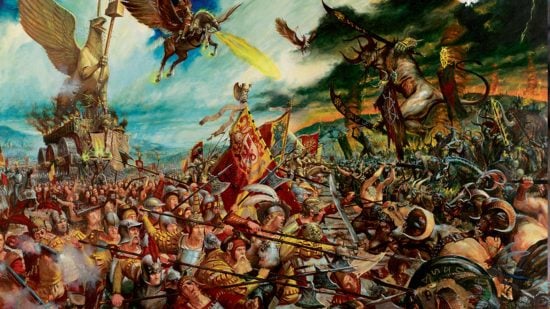
The state of the Empire
The young Empress Magritta of Marienburg was elected to the throne in the year 1979. An outsider candidate, maneuvered into position by a coalition of Electors who had no prospects of claiming the throne themselves, her appointment was deeply unpopular. Chief among her detractors was the Grand Theogenist, head of the cult of Sigmar.
The council collapsed into disarray, effectively signalling the end of the electoral system. The Empire is currently divided into four power blocks. Alongside Magritta are three other claimants to Sigmar’s throne: Sigismund Ulric of northern Osterland; Prince Wilhelm I of Reikland; and Duke Ludwig XII of Talabecland.
How to play the Warhammer Empire
You can play a Warhammer Empire army any way you can imagine. Want loads of infantry? Sure thing. Gunline? You betcha. Knights? On the table. Artillery? No doubt. Heavy Chariots? Available in steam-powered and priest-piloted flavors. Wizards? Of course. Monsters? Griffons on standby. Cavalry? We got them in light, heavy, and monstrous varieties. Skirmishers? Some.
However, an Empire army doesn’t do any single thing better than all other armies. Goblins and the Tomb Kings can both put more infantry bodies on the table, and Elves, Dwarfs, Orcs, and Chaos field infantry that is more aggressive, more durable, or more elite than the Empire. Dwarfs have higher quality guns and more reliable artillery. Chaos can field more heavy chariots and monsters. Bretonnian Knights are superior to the Empire’s, and the Elves have better access to light cavalry skirmishers. Empire wizards don’t even have unique signature spells.
Don’t take this as a knock against the Empire. Their army list is simply flexible. While it can’t be specialised around any one theme as hard as other armies (with the possible exception of a gunline pretty similar to the Dwarfs), it also doesn’t face any of the extreme restrictions, blind spots, or oversights that other armies have. There isn’t even a mandatory Core unit.
Regimental Units and Detachments
Many Empire units, including most of the Core choices, have either or both of the special rules ‘Regimental Unit’ and ‘Detachment’. You’ll find the full explanation for these on page 282-3 of the Warhammer: the Old World rules, but here’s a brief rundown.
When list building, up to one Detachment can be assigned to each of your Regimental Units. The Detachment can contain up to half as many models as the Regimental Unit it’s attached to, and can’t contain a command group. The two units are deployed at the same time, within 3” of each other. As long as a Detachment if within 3” of its Regiment, it borrows its Leadership and any psychology rules.
When a Detachment’s parent Regiment is charged, the Detachment can also make a Charge Reaction, either standing and shooting at the incoming enemy, or making its own charge into that unit and hopefully hitting it in the flank.
Trained State Troops, State Missile Troops, and Empire Greatswords can all be Regimental Units or Detachments, while the informal Free Company Militia and Empire Archers can hang out as Detachments. This gives you a lot of flexibility; units can be fielded alone, with support, or as support, and in each position the unit will perform differently.
Empire Core Units
There are no mandatory Empire Core Units, which makes it worthwhile to consider all the options. The default is definitely a reliable anchor of State Troops with some gunline support, it’s possible to push your army far in a different direction.
State Troops
State Troops are the plain pizza base of the Empire army – everything else you layer on top will work with them. With a very mediocre human stat line, they’re not going to deal much damage in combat. They may still win combats, through a combination of rank bonuses and the extra combat resolution that comes from a flank charging Detachment.
Regiments will generally be on the receiving end of a charge, while Detachments are more likely to make supporting counter-charges. That means Regiments will get most use out of spears and shields, while Detachments will see more benefit from halberds. Both types of unit will benefit from being upgraded to Veterans, which comes with +1WS and superior nerves.
State Missile Troops
State Missile Troops are cheap and basic Close Order ranged units. You can field a Napoleonic style army using units of State Missile Troops with a full unit command and a few ranks to grant them a passable native combat resolution bonus. That can then be supplemented with kills from counter-charging Greatsword Detachments and any stand-and-shoot casualties you inflict.

Free Company Militia
Free Company Militia are ill-disciplined horde infantry that fight a little like Warhammer Skaven. If fielded on their own, take a very large unit to take advantage of the Horde and Warband rule, which grants up to a +3 Rank bonus that the unit can add to its Leadership. If you fancy fielding a People’s Army, bung a Battle Standard Bearer into the unit, equipped with the Griffon Banner, which doubles that rank bonus – just pray you’re never flank charged.
The Warband rule also makes Free Company a reliable Detachment, as it grants them rerolls on charge rolls. Operating in Open Order, they can provide counter charge support through or into awkward terrain, or while standing some way back from the front line.
Empire Archers
Empire Archers are maneuverable, able to Move through Cover and make a Vanguard move. They can be upgraded to be Scouts for one point per model, allowing them to pepper the enemy flanks from the start of the battle.
Archers can fight in Open Order or as Skirmishers. Skirmishing is the right choice if you’re up against a lot of enemy shooting, making them harder to hit and allowing you to screen your other forces.
Against a melee enemy, Open Order can be useful, particularly for units upgraded to Scouts: if your opponent charges the archers, the charging unit will align to face the bowmen, a tool you can use to pull their unit out of the line of battle at an awkward angle.
Empire Knights
You can also ignore all these units entirely, and push hard into cavalry. Empire Knights are some of the most basic heavy cavalry in any army, but they’re also cheap, at just 21 points per model before upgrades. You can field several large units of them along with several mounted characters and your choice of support.
While they can’t pack into your battleline as neatly as Lances of Bretonnian knights, they can be supported by huge batteries of artillery!
Interested in rank and flank wargaming but want to experiment with different models, or different rules? Check out our guide to fantasy wargames for more suggestions.
